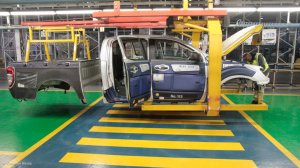Naacam component export sales drop 30% in 2014
Export sales of South African-made components by companies that are members of the National Association of Automotive Component and Allied Manufacturers (Naacam), had decreased 30%, from R8.4-billion, in 2013, to R5.9-billion in 2014, says (Naacam) executive director Robert Houdet.
“This drop may be the result of a lack of competitiveness of the local component manufacturers, as well as the impact of the labour unrest on the attractiveness of sourcing from South Africa.”
Houdet says the impact of a number of crippling strikes affecting the automotive industry over the last 24 months is only now starting to trickle through the system.
“When the strike is over, everyone gets back to work, and business is brisk as companies work to catch up on orders. However, during these strikes, purchasing people abroad, who have to ensure continuity of supply of components to assembly plants, are sweating and having sleepless nights, and South Africa becomes rerated as red.
“Supply contracts can’t be cancelled immediately, but, vehicle manufacturers, over time, seek alternative parts suppliers elsewhere, and contracts with South African suppliers are not renewed.”
The South African automotive industry can still do much to improve its effectiveness and productivity, but the labour issue remains the most important challenge, he adds.
Total annual component sales for Naacam members (around 140 companies) reached R50-billion in 2014, compared with 2013’s R53-billion.
Sales to vehicle assemblers (for assembly purposes) reached R14.2-billion, up from the R13.1-billion recorded in 2013. Houdet attributes the increase to the seven-week strike in the automotive industry in 2013.
Parts and accessories sales to vehicle manufacturers were at R2.4-billion, up from R1.8-billion, while independent aftermarket sales were down to R3.8-billion, from the R4.1-billion recorded in 2013.
Sales to other Naacam members remained static, at R1.5-billion.
Sales of catalytic converters reached R21.3-billion.
Looking outside Naacam, South African tyre manufacturers recorded sales of R10.2-billion in 2014.
The estimated employment at Naacam members shrunk in 2014, to 49 261 people, down from 51 894 in 2013.
Houdet attributes this to increased mechanisation in an attempt to improve cost competitiveness and minimise the negative impact of labour unrest.
Employment at tyre manufacturers fell significantly, to 5 469 people, compared with 6 450 in 2013. Houdet believes the decline is largely owing to the closure of the Apollo factory in Durban.
Catalytic converter manufacturers also shrunk employment, to 3 900 people, down from 5 015 in 2013.
TIER TWO, THREE IGNORED
Tier two and three component manufacturers, supplying parts to tier one suppliers, which, in turn, supply vehicle manufacturers, are “completely ignored” by South African policy makers, says Houdet.
“They are the labour intensive businesses, able to increase employment in the sector.
“The average age of the owners of these businesses is about 60 years old.
“These businesses are going to disappear from the South African landscape, if we don’t act soon.”
Houdet believes this sector of the local automotive industry is best suited to black empowerment initiatives, especially as these suppliers are not multinational entities, as is the case with many tier one suppliers, and all vehicle assemblers.
Another way of boosting the localisation of components is through the implementation of a significant tooling subsidy in government’s Automotive Production and Development Programme, says Houdet.
The support scheme is currently the subject of a government review.
“We have asked for a 75% tooling subsidy from government in order to compensate the relatively low production levels faced by local component manufacturers,” notes Houdet.
“This will hopefully boost the component manufacturing industry, as well as the local tooling industry, which is in desperate need of revival.”
Comments
Announcements
What's On
Subscribe to improve your user experience...
Option 1 (equivalent of R125 a month):
Receive a weekly copy of Creamer Media's Engineering News & Mining Weekly magazine
(print copy for those in South Africa and e-magazine for those outside of South Africa)
Receive daily email newsletters
Access to full search results
Access archive of magazine back copies
Access to Projects in Progress
Access to ONE Research Report of your choice in PDF format
Option 2 (equivalent of R375 a month):
All benefits from Option 1
PLUS
Access to Creamer Media's Research Channel Africa for ALL Research Reports, in PDF format, on various industrial and mining sectors
including Electricity; Water; Energy Transition; Hydrogen; Roads, Rail and Ports; Coal; Gold; Platinum; Battery Metals; etc.
Already a subscriber?
Forgotten your password?
Receive weekly copy of Creamer Media's Engineering News & Mining Weekly magazine (print copy for those in South Africa and e-magazine for those outside of South Africa)
➕
Recieve daily email newsletters
➕
Access to full search results
➕
Access archive of magazine back copies
➕
Access to Projects in Progress
➕
Access to ONE Research Report of your choice in PDF format
RESEARCH CHANNEL AFRICA
R4500 (equivalent of R375 a month)
SUBSCRIBEAll benefits from Option 1
➕
Access to Creamer Media's Research Channel Africa for ALL Research Reports on various industrial and mining sectors, in PDF format, including on:
Electricity
➕
Water
➕
Energy Transition
➕
Hydrogen
➕
Roads, Rail and Ports
➕
Coal
➕
Gold
➕
Platinum
➕
Battery Metals
➕
etc.
Receive all benefits from Option 1 or Option 2 delivered to numerous people at your company
➕
Multiple User names and Passwords for simultaneous log-ins
➕
Intranet integration access to all in your organisation





















